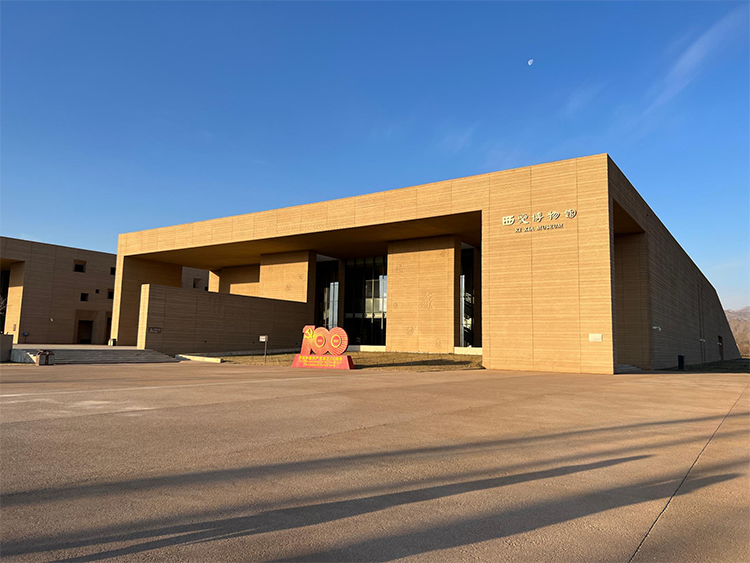Xixia Mausoleums: Visitor’s Guide to the Western Xia Museum and Imperial Tombs
Standing at the foot of the Helan Mountains, a sharp-lined modern building echoes the rolling loess tombs beyond. This is the Xixia Mausoleums Museum, the nation’s only site museum dedicated to the Tangut (partyxiang) civilization and a key to unlocking the Silk Road’s “lost kingdom.” Pass through the bronze gate inlaid with Tangut characters and you’ll encounter the deep sheen of a gilded bronze ox, the glazed brilliance of a chiwen roof beast, and a distinctive aesthetic born where Tibetan Buddhism met Central Plains culture.
1. The building itself is the first exhibit: When modern minimalism meets Xixia totems
The national first-class museum’s architecture hides meanings: tilted geometric facades mimic Helan’s folds, perforated rusted steel panels are inspired by Tangut inscription motifs, and a central courtyard “time tunnel” uses light and shadow to recall the tomb approach. Inside 9,000 square meters, rugged concrete balances delicate display cases as if translating the Xixia ideal of austere, transcendent beauty into contemporary design.
2. Three signature treasures: Touchstones of Tangut royal life
• Gilded Bronze Ox (nationally restricted for export)
Unearthed from Tomb No. 6, this 188-kg gilded bronze ox radiates power through its musculature. Archaeologists believe it was a guardian beast for a “gold-crowned” tomb, its casting showing a fusion of nomadic tradition and Central Plains metallurgy.
• Tangut Inscribed Stele Fragment “Lingzhi Ode”
This weathered stone bears Tangut script—an elaborate writing system borrowing strokes from Chinese characters but far more complex. After the fall of Xixia the script vanished for centuries; an interactive touchscreen lets visitors try decoding this royal garden ode.
• Green-Glazed Chiwen Roof Beast
Reconstructed from royal tomb ruins, this dragon-headed, fish-tailed roof guardian is glazed with cobalt introduced from Persia—direct evidence of Xixia’s role as an east–west trade hub. Under curated lighting, its turquoise scales remain mesmerising.
3. Immersive history theatre: From nomadic clan to Buddhist kingdom
The permanent “Xixia History and Culture” exhibition strings together over 2,000 artifacts—armour, seals, thangka paintings—to tell how Tangut rulers formed a multi-ethnic state and implemented a Five-Code legal system blending Han, Tibetan, and Uighur laws. In the “Excavated Artifacts” wing, a 3D-recreated burial chamber sits beside real stone guardian statues, revealing a Xixia worldview that treated death as a continuation of life.
Don’t miss the hidden highlight: the underground digital dome.
A 10-minute holographic projection recreates Li Yuanhao’s 1038 enthronement with music reconstructed from Xixia musical notation and Pipa arrangements.

4. Practical tips: Be a smart time-traveler
Best times to visit
• Arrive at opening (09:00) and head straight to the gilded bronze ox exhibit to avoid crowds.
• On Fridays the museum extends hours to 20:00—perfect for viewing the mausoleum landscape at sunset.
Suggested routes
• Quick tour (1.5 hours): Entrance hall → Gilded Bronze Ox → Tangut interactive zone → Glazed Chiwen → Digital dome
• In-depth visit (4 hours): Add the archaeology lab (open Tuesdays and Thursdays) and a hands-on Tangut rubbing workshop (reserve in advance)
Foreign visitor tips
• All labels are bilingual; AR glasses with eight-language narration are available at the entrance.
• Book tickets online with your passport; onsite kiosks accept Visa.
• Closed Mondays (except public holidays); some mausoleum areas may be closed in winter.

5. Nearby extensions: Continue your 11th-century journey in Yinchuan
After the museum, deepen your Xixia experience:
1) Take the electric shuttle to the mausoleums’ core zone to compare Tomb No. 3 (rumored Li Yuanhao tomb) with Ming imperial tomb layouts.
2) Drive 20 minutes to Xixia Cultural Park to watch performers in Tangut dress demonstrate blacksmithing and divination.
3) Dine at longtime local favorite “Guoqiang Hand-Pulled Mutton” to taste the rich lamb dishes rooted in Xixia pastoral traditions.
When sunset gilds the Helan range you’ll understand why the Tangut placed their royal tombs here: in a land framed by mountains and the Yellow River, a dynasty’s ambition and beliefs are being reborn through museum architecture, artifacts, and stories.


